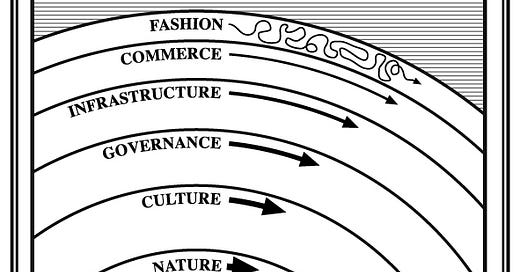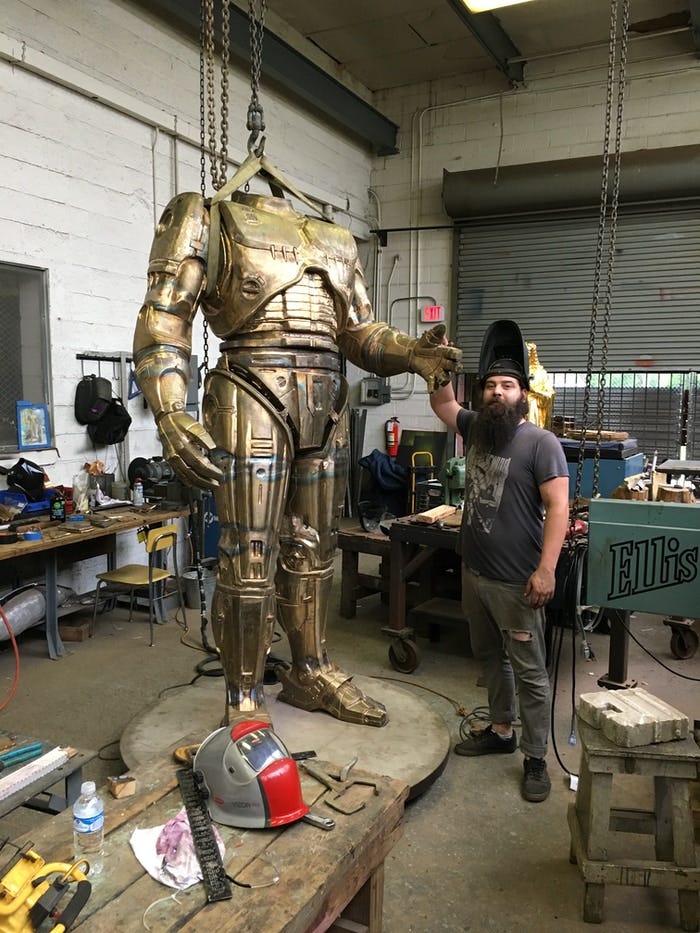Urban Technology at University of Michigan week -21
The implications of wallstreetbets for cities and a digression about Robocop
If you’ve paid any attention to the internet this week, then you probably heard about a group of Reddit r/wallstreetbets memelords who juiced GameStop on the New York Stock Exchange and stuck it to hedge funds in the process. If not, here’s the overview and these two stories describe the deeper cultural dynamics. A company that sells video games doesn’t have much bearing on urban technology, but the underlying dynamics at play here are certainly relevant.
Previous social media swarms fueled the Arab Spring uprisings 2010-2012, enabled #metoo in 2017, led to the creation of a Robocop sculpture in Detroit, and swarmed the US Capitol just a couple weeks ago. These are all examples of how collective action via social media accelerated shifts in governance and culture that felt sluggish if not stymied otherwise. This is certainly relevant to the future of cities because urban change can feel so hard but also—and this is an important also—cities are in the process of becoming more automated, which is a change that has been underway with the stock markets for decades already.
Hello! I’m Bryan Boyer, Director of the Urban Technology degree at University of Michigan that will welcome its first students in the 2021-2022 academic year. If you’re new here, try this 90 second video introduction. While we launch the program, we’re using this venue to explore themes and ideas related to our studies. Thanks for reading. Have questions about any of this? Hit reply and let us know.
🎡 Impatient Layers
One cool aspect of this week’s wallstreetbets news is how activity that’s largely commercial (individual investors buying stocks) and of-the-moment (memes) is leading to much deeper conversations about the fairness of the economy and the rules by which funds, clearing houses, and other cogs of the economy function. Author Stewart Brand describes this with a diagram of “pace layers” showing how some parts of society like fashion move really fast compared to others, like government.
Here’s how Brand’s describes the way the relationship between the layers:
Fast learns, slow remembers. Fast proposes, slow disposes. Fast is discontinuous, slow is continuous. Fast and small instructs slow and big by accrued innovation and by occasional revolution. Slow and big controls small and fast by constraint and constancy. Fast gets all our attention, slow has all the power.
Pace Layers suggests that rather than giving up on meaningful change the question is how the possibility of impatience may be created. To Brand’s diagram we must find a way to add an impatient layer so that it’s possible for, as Hemingway put it, change to occur “gradually and then suddenly.” This week’s episode with GameStop feels like it’s the “suddenly” part of that equation, but is more likely to be just the end of the beginning. We’ve yet to see what this little revolution leads to in terms of more lasting change beyond the millions that were made by a few and the crocodile tears being cried by a handful of fund managers.
In this case, GameStop is an example of activity in the Fashion/Commerce layers forcing Governance/Culture to accelerate and change more quickly than they previously had under the status quo. Given that this situation is still dynamic, the question is whether the lasting outcomes of this week will be largely positive, as they were with #metoo, or problematic, as they were with the Capitol insurrection.
Will this week lead to further moves toward decentralized finance that operates independent of big banks and financial systems? Will those options become more user friendly so that people can participate without being crypto wizards? Will it lead to changes that rebalance the scales between the tippy top of the wealth distribution curve and everyone else?
And what does this have to do with cities?
Today, some billions of transactions are made on the NYSE, most of them processed at high frequency and without human intervention. Before automation in the form of high frequency trading became normalized, stock markets were slower and trades processed by humans wearing funny jackets. Now think about your hometown. As automation—that’s a fancy way to say software—increasingly plays a role in mobility, maintenance, parking, policing and so many other core functions of urban life, things get more responsive and also dynamic. What can swing up can also crash down. NYSE suffered a flash crash that caused it to lose nearly 9% of its value in minutes. What would the equivalent be in municipal services?
More flexibility in urban services can be positive, like autonomous vehicles that shuttle people along last mile routes, effectively turning your front door into a bus stop only when you need it. The same shuttle can drive a completely different route every night, or even every hour, and not get lost in the shire. Could that flexibility be used by a coordinated mob to disrupt movement within a city by, say, clogging roads with a flash of last mile requests? Sure, the risk exists, even if it sounds like something from a movie.
Here’s a less flamboyant possibility. Once an urban population is booking a significant percentage of its rides via a Mobility as a Service app and the city has good data about the flow of its residents, cities might (and probably should) use that and other data sources like community input to locate stops along future bus routes. This could be a boon to decision making, by reducing the cost of research that usually goes into such a process and making it possible to execute quickly and often. On its face this sounds like a great way to be responsive to community need, and it is… but responsiveness cuts both ways.

What happens when a grumpy group of neighbors want to shift the routes because they believe that public transit brings “undesirables” to “their” part of town? This classic cry of NIMBYism is bad enough today, when such discrimination is still often reliant upon “professional citizens” who make it their business to be present and be heard at community meetings. Imagine how much more chaotic algorithmic NIMBYism will be! Governments that utilize automated systems to collect and evaluate commentary will need to work diligently to maintain an equitable process that ensures meme-fueled Black Swans are not mobilized to discriminate against Black bodies, and so much more.
A cheeky example comes to us by way of Detroit (Remember what I said about Michigan being the Kevin Bacon of US states? See, it’s true!) which will someday soon be home to a 7ft tall status of everyone’s favorite public defender, Robocop. This began as a Kickstarter initiated in 2011 by locals with a respect for cinema and some free time. ‘Detroit Needs A Statue of Robocop!’ was one of the first Kickstarter campaigns to be situated in a physical place, in fact, so it opened some important questions at the intersection of internet mobilized action and situated communities.
Should people from Ann Arbor have a say in whether a neighboring town 40 minutes to the west gets a new statue? What about folks from Atlanta, Cape Town, or Helsinki? Should people from out of town be allowed to have a say at all? Should people from all over Detroit have input, or would it make more sense to limit the input to those who live within a certain distance of the potential Robocop? This is a 21st century question and one without clear answers yet.
Dave Bing, Mayor of Detroit at the time, thought there was no place in his city for the statue, despite cheeky responses from a widespread many who wanted to see the statue realized. It was remarkable that a group of Kickstarter backers managed to make enough noise that the Mayor of a major American city had to publicly address something as random as a Robocop statue.
This week’s GameStop episode makes that look like a tiny blip on the weirdness radar. What happens when the coordination, speed, and programmability that made it possible for a meme to take down a hedge fund start playing out in your neighborhood? Will your city be ready for it?
As a designer or engineer, are you content to work within your little silo of the pace layers diagram—furniture designers churning away on the fashionable, civil engineers dutifully working on the infrastructural—or are you able to connect your work to adjacent layers in a way that makes reasonable the previously impossible? Do you work within the stripes of the diagram or do you cut across them with impatience?
BTW - the pace layers diagram and the power of being impatient is so important to me that I made little pins out of the concept. If you come to University of Michigan to study Urban Technology and you ask nicely, I’ll give you one.
Links
🗺 “To our knowledge, this is the first analysis of property ownership and land use along the entire US-Mexico border with this kind of detail.” Developed by Detroit-based Loveland Technologies, which is run by Jerry Paffendorf aka co-creator of the Robocop Kickstarter.
🚏 This story about renaming the streets of Brooklyn is great and also very nicely presented online (as we’ve come to expect from the NYT digital team).
🍔 YouTube persona Mr. Beast has launched a burger chain by colonizing existing restaurants. Translation: ghost kitchens are real but don’t replace traditional restaurants, they supplement them. Translation 2: fascinating that you can effectively containerize a restaurant and deploy it with minimal investment. Translation 3: More evidence that the future is always weirder than expected.
🪄 Here are some things that come in the shape of a line: magic wands, lasers, asparagus, and now cities. Allisson Arieff weighs in on Saudi Arabia’s plans for a half-trillion dollar linear city.
🕶 Thinking a little about AR and VR these days and how it’s such lifeless technology still. Inspiration could be taken from these indigenous snow goggles made from whalebone.
This week: Kinda sorta back online. Call with Cynthia. Call with Anthony. Wrote a thing with bullet points. Deleted half of them. Admissions crunch begins next week because February 1st is the deadline for applications. This is really happening! 🏃♂️







One observation on how Brand’s describes the way the relationship between the layers: Fast proposes, slow disposes => Fast disposes, slow assimilates thinking about fashion disposable products and nature's role of 'decomposing' the waste produced...